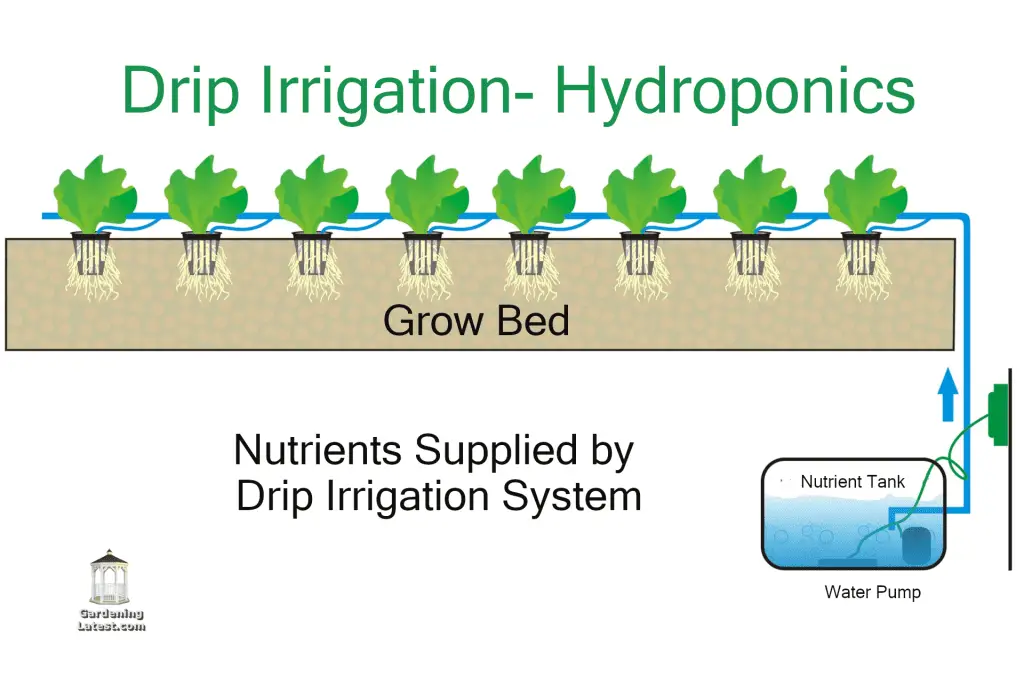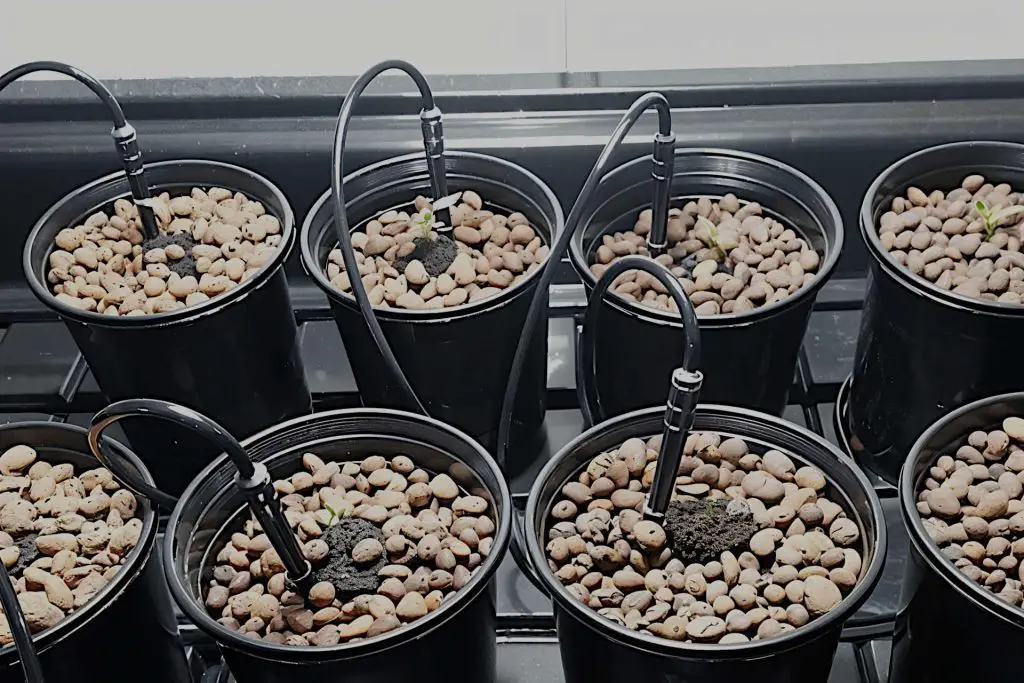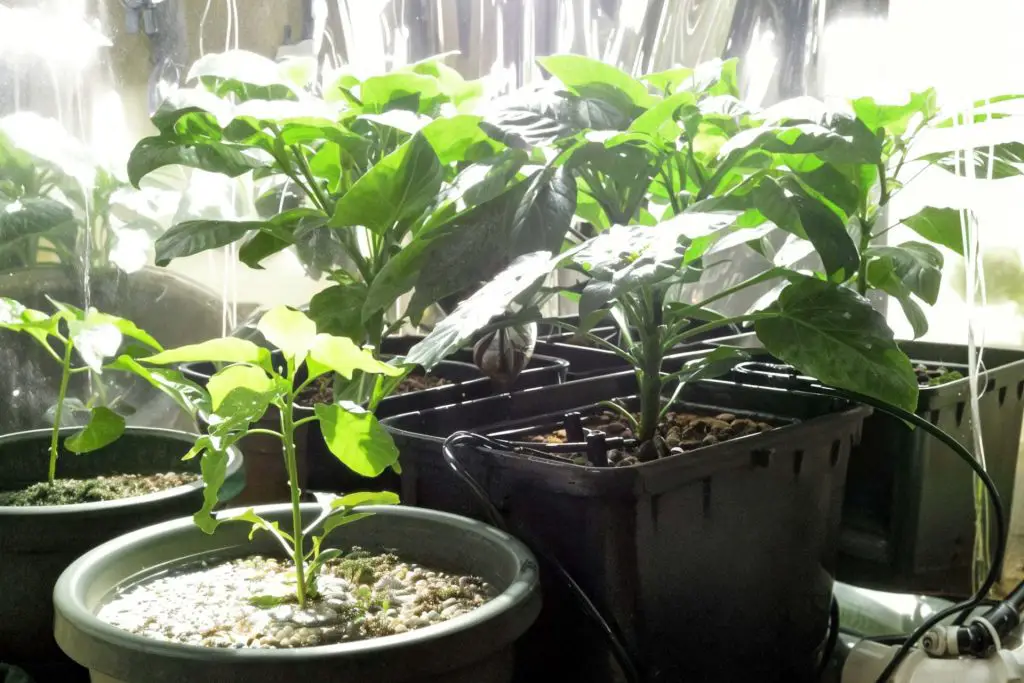Drip System Hydroponics: What It Is and How to Get Started
Drip hydroponics is a system of gardening in which water, nutrient solution, and air are delivered to plants via tubing. The drip system hydroponics facilitates vigorous plant growth while minimizing water waste. In fact, the watering schedule for most drip system hydroponic gardens is much less frequent than that is needed with traditional garden irrigation methods.
One of the main benefits of drip system hydroponics is that it results in reduced water use; this can be especially important during times of drought or when expensive irrigation resources are unavailable. Drip systems also conserve moisture by delivering moisture directly to the roots of plants, rather than water droplets bouncing off the leaves and into the air.
The main benefits of drip system hydroponics include:
- Reduced water use
- Conserves moisture by delivering moisture directly to the roots of plants
- Granular control
- Facilitates vigorous plant growth
- Grow larger plants than other hydroponic systems
How Do Hydroponic Drip Systems Work?

The drip system hydroponic system works by distributing water, nutrient solution, and air to plants through the tubing. The tubing is positioned so that the water, nutrient solution, and air reach the roots of the plants. This system facilitates vigorous plant growth while minimizing water waste. The timing of irrigation in drip system hydroponic gardens is much less frequent than that used in traditional garden irrigation methods.
Type of Systems
There are various types of drip systems. The most common type is the “peristaltic” system. This is a basic peristaltic pump, which uses a solenoid valve and pressure-relief chamber to regulate the flow of water through the drip line.
This allows for efficient and controllable delivery of water to each plant. The only drawback is that it can become quite expensive in terms of maintenance costs if you need to replace components or fix leaks.
In some cases, it can be cheaper to use an inline dripper pump instead of a separate peristaltic pump. This will save on energy costs as well as space requirements since they can fit within existing infrastructure like piping and plumbing already installed.
An inline drip system has the added advantage of being able to water multiple plants simultaneously without any interruption in flow.
Another common type of drip system is based on timer irrigation. This system uses an irrigation timer to activate the pump at specific intervals, typically every 12 or 24 hours. The watering cycle will then continue until the timer expires, at which point the pump will turn off automatically. There are two primary varieties of timers: analog and digital, and each kind comes in a wide range of sizes and designs to accommodate a variety of applications.
Timer irrigation systems are often less expensive than peristaltic systems.

How Excess Nutrient Solution Is Treated
There are two methods of dealing with the excess nutrient solution. It can either be returned to the reservoir or collected and disposed of.
Recirculating Systems (Recovery System
In recovery systems, excess water is recirculated back into the reservoir. This means that you don’t have to constantly refill the system with new nutrient solution.
These systems do not use a timer. The pump is run continuously, and the excess water is used to flush the system through a dripper or sprayer.
In such drip systems, you can adjust the amount of water by changing the flow rates of your pump and emitter lines. These settings are available with most hydroponic controllers that come with an LED screen showing data like EC (Electrical Conductivity), ppm (Parts Per Million) etc..
Recirculating/Recovery Systems can be used in for large commercial farms or smaller gardens as they can be set up easily without adding any complexity
Non-Circulating System (Non-Recovery System)
In non-recirculating systems, the excess water that is left in the reservoir is allowed to evaporate and condense back into the medium. This means that there is no flow back of water from the reservoir.
In a non-recirculating system, you can easily maintain a precise pH level of your nutrient solution without worrying about changing it periodically.
This type of system does not use a reservoir. Instead, the nutrient solution is constantly circulated through tubing that connects to plant roots. This system allows for titration of the nutrient levels in your hydroponic system with precision but it also requires regular maintenance
An advantage of this type of system is that you can have several plants growing at once without any interference from one another. And since there are no reservoirs to fill shortages or over-fertilize plants, these systems tend to be cheaper than recirculating drip systems.
What Equipment Do You Need to Create a Hydroponic Drip System

To create a hydroponics drip system hydroponics system, you will need:
Nutrient Reservoir
A reservoir is the lowest common denominator of hydroponic systems. A reservoir is a container that holds the water and nutrients for all of the plants in your system.
Timer (optional)
A timer is used to control the duration of the nutrient solution flow. It may be necessary to set a timer for every day you water your plants.
Watering System: Aeration and Pumps
Water pump and aerator combo unit (aerators) or individual water pump and air pump are important elements of a recovery drip system, although gravity can be used to move the water supply through the system as well in non-recirculating systems.
An aerator is essential for hydroponics systems as it mixes air into the reservoir water/nutrient solution and oxygenates your plants’ roots. Without an aerator, there would be little oxygen for plant roots to absorb from the air and grow healthy.
The pump supplies enough pressure so that each section of tubing can feed itself with nutrients and oxygenated water from the system’s reservoir through its drip emitters. The pump also circulates water through the system so that even roots at the farthest corners of your hydroponic garden get enough moisture and nutrients.
Tubing and Connectors
The tubing is connected to the reservoir, which holds the nutrient solution. The tubing provides the pathway for the nutrient solution through which it travels to reach each plant. This type of tubing is typically made from polyethylene, vinyl irrigation tube, or PVC irrigation pipe.
Drip Emitters

Drip emitters provide efficient and controllable delivery of water and nutrients to plants’ roots. The spaghetti tubing branches off at the end, where a nozzle is placed which delivers the nutrient solution. Drip emitters provide efficient and controllable delivery of water and nutrients to plants’ roots.
Drip Irrigation Controllers
A drip irrigation controller provides control over the water/nutrient solution. It is needed for each plant so that you can manage how much water is delivered from the reservoir to each individual plant. It also regulates how much time passes between watering intervals. Watering intervals should be programmed using a timer (see below).
Plant Pots / Holders
The plant pots or holders are used in hydroponic drip systems to house each individual plant.
Growing Medium for Hydroponic Drip System
You can place a growing medium or substrate around the bottom of the pot or nursery container that each plant is in. Some examples of growth media or substrates are LECA balls (clay pellets), Rockwool, perlite, vermiculite, and coconut coir. The medium will help the plant maintain its stability while allowing sufficient oxygen to enter and keeping precisely the right amount of water and nutrients.
The growing medium is not essential for hydroponic drip system irrigation, but it can help to improve plant growth and water uptake.
Collection Tray
This tray is used to catch excess water from your plants and allow it to drain back into the system or be discarded depending on the system used.
Hydroponic Nutrient Solution
Plant nutrients (or “fertilizers”) are applied directly to plants by applying them via drip irrigation or a water-soluble fertilizer mix. Nutrients such as nitrogen, phosphorus, and potassium that are present in the fertilizer help feed and sustain the plants. The right balance of these three nutrients is crucial for the health of your plants. Too much or too little of one nutrient will result in unhealthy growth or no growth.
pH Tester
A PH tester is a simple device that checks the pH level of your water. It may be used to adjust your pH level if it is too low or high, which will change the characteristics of the nutrient solution.
Timer (optional)
A timer is used to control the duration of the nutrient solution flow. It may be necessary to set a timer for every day you water your plants. In general, try not to run it more than 3 days in a row.
Set Up The System
Once you have all of the necessary equipment, setup your system by following these instructions:
- Connect the tubing to the water reservoir and drip irrigation system
- Connect the tubing to plants
- Set drip system timer for desired watering time
- Depending on your system monitor pH and nutrient levels in the nutrient solution.
Hydroponic Drip System Timing: How To Get a Big Yield from Small Space?

There are so many ways you can do this. It really depends on what you want to grow, but here are a couple of examples:
Example 1: Leafy greens or other fast-growing vegetables such as cabbage, spinach, or lettuce. You could have up to 4 trays per square foot and they’d all be harvested at different times each week (or whatever suits your schedule). If you have only 2 inches of depth in the tray then they may only need water every other day.
Example 2: Tomatoes or peppers. These can be grown in much deeper containers, up to 12 inches deep, so you could have more of them per square foot and harvested at different times as well (again, based on your schedule). Both of these crops will need water daily though!
One important thing to keep in mind is that hydroponics systems are designed for growing plants indoors; if you’re looking to grow fruits and vegetables outdoors then a system that relies on irrigation from rainfall or a groundwater reservoir would be better suited.
What Are the Benefits of Using a Drip System?
Drip system hydroponics offers several benefits that make them a popular choice for home gardeners and commercial growers. They are easy to set up, and you don’t have to worry about adding any complexity or complications.
Another advantage of drip system hydroponics is that they allow for precise control of the pH level of your nutrient solution. You can avoid changing the solution regularly, which can save you time and hassle.
Non-recirculating drip systems also tend to be cheaper than recirculating systems. And since there is no need to constantly replenish a reservoir, these systems are less likely to require regular maintenance.
The drip system also allows you to grow larger plants that other hydroponic systems can’t accommodate.
What Are the Best Plants to Grow Using a Hydroponic Drip System
If you are growing plants in a drip system hydroponics system, there are several types of plants that will be best suited for the setup. These include tomatoes, cucumbers, peppers, and beans. As mentioned the drip system also allows for larger plants such as squash, melons, and Zucchini to be grown.
Each plant requires different levels of water and nutrients to thrive, so it is important to have a system that can accurately supply these essential elements to your plants. A hydroponic drip system setup allows you to precisely regulate the amount of water and nutrient that is delivered directly to your plant roots. This makes it easier than ever for gardeners to get the most out of their crops!
How Do I Keep My Hydroponic Drip System Clean and Running?
To keep your hydroponics drip system clean and running at its best, it is important to regularly inspect it for problems. Problems can include clogged irrigation tubing, waterlogged plants, or poor drainage. Once you identify a problem, take action to correct the situation as quickly as possible.
Starting a Hydroponics Drip System
Overall, a hydroponic drip system is an easy and efficient way to grow plants indoors. They offer many advantages over traditional gardening practices, making them a popular choice for both home growers and commercial growers. By following a few simple tips, you can ensure that your hydroponic drip system runs smoothly and efficiently.
